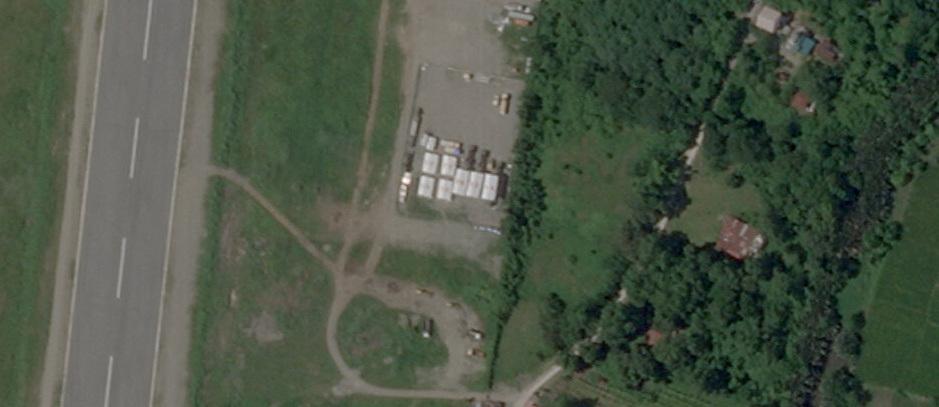The US has no immediate plans to withdraw a mid-range missile system deployed in the Philippines, despite Chinese demands, and is testing the feasibility of its use in a regional conflict, sources with knowledge of the matter said.
The Typhon system, which can be equipped with cruise missiles capable of striking Chinese targets, was brought in for joint exercises earlier this year, both countries said at the time, but has remained there.

Photo: Planet Labs Inc via Reuters
The Southeast Asian archipelago, Taiwan's neighbor to the south, is an important part of US strategy in Asia and would be an indispensable staging point for the military to aid Taipei in the event of a Chinese attack.
China and Russia have condemned the first deployment of the system to the Indo-Pacific, accusing Washington of fueling an arms race.
China's Ministry of Foreign Affairs yesterday said it was very concerned about the plan to keep the system in place.
"It seriously threatens the security of regional countries and intensifies geopolitical confrontation," ministry spokesperson Lin Jian (林劍) told a press briefing.
The deployment, some details of which have not been previously reported, comes as China and US defense treaty ally the Philippines clash over parts of the hotly contested South China Sea.
Recent months have brought a series of sea and air confrontations in the strategic waterway.
Philippine officials said Philippine and US forces continued to train with the missile system, which is on the northern island of Luzon, facing the South China Sea and is close to the Taiwan Strait.
They said they were not aware of immediate plans to return it, even though the joint exercises end this month.
A Philippine army spokesman, Colonel Louie Dema-ala, on Wednesday said training was ongoing and it was up to Philippine authorities and the US Army Pacific (USARPAC) to decide how long the missile system would stay.
"It is up to the higher headquarters to decide on its stay, and most importantly the USARPAC because they own this, it is not our capability," he told Reuters.
A public affairs officer for USARPAC said the Philippine army had said the Typhon could stay beyond this month and soldiers trained with it as recently as last week, engaging "in discussions over employing the system, with a focus on integrating host nation support."
A senior Philippine government official and another person familiar with the matter said the US and the Philippines were testing the feasibility of using the system there in the event of a conflict and how well it works in that environment.
Both spoke on condition of anonymity.
The government official said the Typhon — which is intended to be mobile and moved as needed — was in the Philippines for a "test on the feasibility of deploying it in country so that when the need arises, it could easily be deployed here."
The office of Philippine President Ferdinand Marcos Jr did not respond to a request for comment.
The US army flew the Typhon, which can launch missiles including SM-6 missiles and Tomahawks with a range exceeding 1,600km, to the Philippines in April in what it called a "historic first" and a "significant step in our partnership with the Philippines."
A satellite image taken on Wednesday by Planet Labs, a commercial satellite firm, and reviewed by Reuters showed the Typhon at the Laoag International Airport in Ilocos Norte Province.
The senior government official who spoke to Reuters said there were no immediate plans to withdraw it.
"If ever it will be pulled out, it is because the objective has been achieved and it may be brought [back] in after all the repairs or the construction would have been done," the official said, adding that there was strategic value for the Philippines in keeping the system to deter China.
"We want to give them sleepless nights," they said.
The US has been amassing a variety of anti-ship weapons in Asia, as Washington attempts to catch up quickly in an Indo-Pacific missile race in which China has a big lead, Reuters has reported.
Although the US military has declined to say how many will be deployed in the Indo-Pacific region, more than 800 SM-6 missiles are due to be bought in the next five years, according to government documents outlining military purchases.
Several thousand Tomahawks are already in US inventories, the documents showed.
China has denounced the deployment of the Typhon several times, including in May when Chinese Ministry of National Defense spokesman Colonel Wu Qian (吳謙) said Manila and Washington had brought “huge risks of war into the region.”
Russian President Vladimir Putin in June cited the deployment when announcing his country would resume production of intermediate and shorter-range nuclear-capable missiles.
Philippine Foreign Affairs Secretary Enrique Manalo in July assured his Chinese counterpart the presence of the missile system in his country posed no threat to China and would not destabilize the region.
China has fully militarized at least three of several islands it built in the South China Sea, which it mostly claims in full despite a 2016 arbitral ruling that backed the Philippines, arming them with anti-ship and anti-aircraft missiles, the US has said.
China says its military facilities in the Spratly Islands (Nansha Islands, 南沙群島) are purely defensive, and that it can do what it likes on its territory.

A new online voting system aimed at boosting turnout among the Philippines’ millions of overseas workers ahead of Monday’s mid-term elections has been marked by confusion and fears of disenfranchisement. Thousands of overseas Filipino workers have already cast their ballots in the race dominated by a bitter feud between President Ferdinand Marcos Jr and his impeached vice president, Sara Duterte. While official turnout figures are not yet publicly available, data from the Philippine Commission on Elections (COMELEC) showed that at least 134,000 of the 1.22 million registered overseas voters have signed up for the new online system, which opened on April 13. However,

EUROPEAN FUTURE? Albanian Prime Minister Edi Rama says only he could secure EU membership, but challenges remain in dealing with corruption and a brain drain Albanian Prime Minister Edi Rama seeks to win an unprecedented fourth term, pledging to finally take the country into the EU and turn it into a hot tourist destination with some help from the Trump family. The artist-turned-politician has been pitching Albania as a trendy coastal destination, which has helped to drive up tourism arrivals to a record 11 million last year. US President Donald Trump’s son-in-law, Jared Kushner, also joined in the rush, pledging to invest US$1.4 billion to turn a largely deserted island into a luxurious getaway. Rama is expected to win another term after yesterday’s vote. The vote would

ALLIES: Calling Putin his ‘old friend,’ Xi said Beijing stood alongside Russia ‘in the face of the international counter-current of unilateralism and hegemonic bullying’ Chinese President Xi Jinping (習近平) yesterday was in Moscow for a state visit ahead of the Kremlin’s grand Victory Day celebrations, as Ukraine accused Russia’s army of launching air strikes just hours into a supposed truce. More than 20 foreign leaders were in Russia to attend a vast military parade today marking 80 years since the defeat of Nazi Germany in World War II, taking place three years into Russia’s offensive in Ukraine. Putin ordered troops into Ukraine in February 2022 and has marshaled the memory of Soviet victory against Nazi Germany to justify his campaign and rally society behind the offensive,

CONFLICTING REPORTS: Beijing said it was ‘not familiar with the matter’ when asked if Chinese jets were used in the conflict, after Pakistan’s foreign minister said they were The Pakistan Army yesterday said it shot down 25 Indian drones, a day after the worst violence between the nuclear-armed rivals in two decades. Pakistani Prime Minister Shehbaz Sharif vowed to retaliate after India launched deadly missile strikes on Wednesday morning, escalating days of gunfire along their border. At least 45 deaths were reported from both sides following Wednesday’s violence, including children. Pakistan’s military said in a statement yesterday that it had “so far shot down 25 Israeli-made Harop drones” at multiple location across the country. “Last night, India showed another act of aggression by sending drones to multiple locations,” Pakistan military spokesman Ahmed